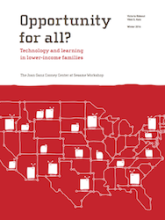
Fast, affordable Internet access for all.

A recent report by Victoria Rideout and Vikki S. Katz from the Joan Ganz Cooney Center at the Sesame Workshop delves into detail on the experiences of lower income families and Internet access. The report, “Opportunity for all? Technology and learning in lower-income families,” points to the promises of digital inclusion for educational opportunities, but also to the current inequalities in Internet access.
The researchers highlight several key findings from the study in an effort to inform policymakers of the root causes, and effects, of these inequalities on lower-income families. They include issues of race (families headed by Hispanic immigrants are less connected), of access (mobile-only and inconsistent connectivity), and of affordability (despite the existence of discounted programs).
Discounted Programs Not Working
We’ve written several times about the failings of the large corporate providers’ discounted programs for Internet access. Over the past few years, Comcast’s Internet Essentials program has been a prime example. We reported on the Consumerist article that highlighted how the program benefits Comcast more than lower-income families. In 2013, our Lisa Gonzalez shared her own family’s experience with the program.
Rideout and Katz’s report again show the real impact of these programs’ failures. Only 5% of those surveyed had ever signed up for the programs although many met the eligibility requirements. Even those that did receive the service sometimes found that it could not meet their needs. After all, the program only provides up to 5 megabits per second (Mbps) in download speeds. A parent of a seventh grader in Colorado explained to the researchers (page 11):
I had (Internet Essentials) because (my children) had assignments that they needed the computer for... I hated it. It wasn’t working. It was too slow, it would freeze and they couldn’t get anything done. We had it for almost a year. I just got rid of it. I was paying $10 (a month) to not use it.
A Better Solution: Community
The report from Rideout and Katz at the Sesame Workshop found that the largest barrier for Internet access in lower-income households is financial. The researchers detail the many ways that better Internet access would provide better education opportunities for lower-income children, and the survey shows that parents know this too.
So, why haven’t these discounted programs been effective in bridging the digital divide? The programs aren’t readily available. Enrollment is confusing. And, more importantly, people outside the community run these programs - people who don’t know what the community needs.
Chattanooga’s municipal network offers a better solution. Chattanooga took the best aspects of Comcast’s Internet Essentials program and combined them with a deep understanding of community needs. An effective policy for providing affordable Internet access must be rooted in the community.
